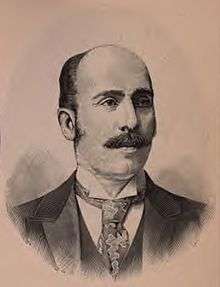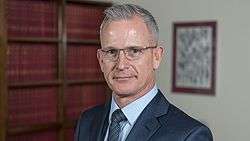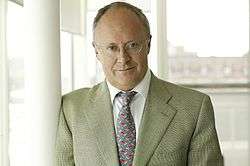Sutton Grammar School
 | |
| Mottoes | Keep Faith / Floreat Suttona |
|---|---|
| Established | 1899 |
| Type | Grammar school, academy |
| Headmaster | Gordon Ironside |
| Location |
Manor Lane Sutton London SM1 4AS England Coordinates: 51°21′54″N 0°11′23″W / 51.36509°N 0.18974°W |
| DfE number | 319/5404 |
| DfE URN | 136787 Tables |
| Ofsted | Reports Pre-academy reports |
| Students | 839 |
| Gender | Boys |
| Ages | 11–18 |
| Houses | Blue, Brown, Green, Red |
| Colours | Maroon and Black |
| Publication | The Suttonian |
| Website |
www |
Sutton Grammar School (until 1 June 2011 "Sutton Grammar School for Boys") is a selective, single-sex Victorian grammar school for boys aged 11–18 inclusive. Located in the south of Greater London, the School's main site is in Sutton and its playing fields are in the neighbouring Cheam Village.
History
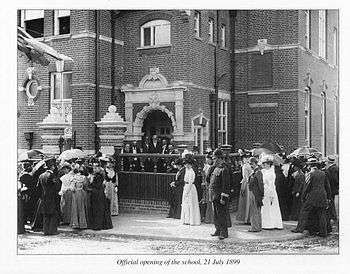
Early life
The School opened in 1899 with an intake of only 19 boys. It has always been an all-boys school, selective in nature, and began life charging fees of £2 10s per term. The School has undergone several name changes; it used to be known as Sutton County Grammar School, and later Sutton Manor School (owing to its proximity with the old Sutton Manor).[1]
The first Headmaster of the School was Mr E H Hensley, who read Mathematics at Cambridge University and became a wrangler by achieving a first class degree.[2] The first Second Master (or Deputy Headmaster) was Mr L A Valencia, who read Classics at Cambridge University.[2]
The School was founded on a site between Throwley Way and the High Street in Sutton, and officially opened in a ceremony on 21 July 1899. The current main building was opened in 1928 on Manor Lane, directly opposite Manor Park in Sutton.[3]
The Sutton School Song was composed in 1935 by the Chairman of the Governors, Canon Courtenay Gale, and the words were written by Mr Horn, a classics master, with the School motto, "Floreat Suttona" (Latin: "May Sutton flourish"), as the refrain. In 1954, however, "Keep Faith" was adopted as the motto, with "Floreat Suttona" being used only occasionally, for example, as a sign off in communiqués to old boys of the School (known as "Old Suttonians").[3]

Modern

Since 1 June 2011, the School has had academy status, and its name formally changed from "Sutton Grammar School for Boys" to "Sutton Grammar School", although it remains an all-boys school.
The current Headmaster is Mr G D Ironside, who read Natural Sciences at Cambridge University. The current Deputy Headmistress is Mrs I Sutherland, who read Philosophy at the University of Warwick.
The School is divided into three sections – the Lower School (Years 7–9), the Upper School (Years 10 and 11) and the Sixth Form – each of which attracts its own dress code. Uniform consists of a maroon blazer with a house tie in the Lower School, a black blazer with a house tie in the Upper School and a lounge suit and tie of the pupil's choice in the Sixth Form.
The School operates a prefect system with a Head Boy, two Deputy Head Boys, Senior Prefects and part-time Prefects from the Sixth Form.
In popular culture
Scenes for the Hollywood film Black Sea, starring Jude Law and directed by Kevin Macdonald, were shot outside the School on 1 August 2013. Law appears in the scenes getting in and out of a car whilst pupils walk out of the School in the background.[4][5]
Fictional music character Mr B The Gentleman Rhymer, who performs "chap hop" (hip-hop delivered in a Received Pronunciation accent), is described as having attended the School by his creator, Jim Burke, a British parodist.[6]
A prank played by pupils at the School attracted national press coverage, including from The Sun, and generated online debate in 2009. Pupils moved numerous bricks onto the roof of the main building to spell out a rude word in large letters, which was spotted on Google Earth.[7][8]

Headmasters and headmistresses
| Date | Headmaster/Headmistress |
|---|---|
| 1899–1925 | Mr E H Hensley |
| 1925–56 | Mr J A Cockshutt |
| 1956–76 | Mr F A Walch |
| 1976–84 | Mr A P W Collins |
| 1985–90 | Mr N P O Green |
| 1990–present | Mr G D Ironside |
| Date | Deputy Headmaster/Headmistress |
|---|---|
| 1899–1934 | Mr L A Valencia |
| 1934–50 | Mr H Morris |
| 1950–66 | Mr A M Lorimer |
| 1966–77 | Mr G Scott |
| 1977–89 | Mr R G Disley |
| 1989–2007 | Mr G G Gibson |
| 2007–present | Mrs I Sutherland |
Academics
.jpg)
The School is consistently ranked amongst the top schools in the country. It placed 13th out of all secondary schools in England in academic league tables in 2015, placing it in the top 0.05%.[9]
In 2016, The Independent described the School as part of "a small group of elite feeder schools" in South East England that sends a disproportionate number of pupils to Oxbridge and contributes to a north-south bias in Oxbridge admissions. The article stated that 9% of pupils at the School are admitted to Oxbridge.[10]
One of the School's pupils, Krtin Nithiyanandam, received national press coverage in 2015 after he developed a test for Alzheimer's disease and autism aged 15.[11] He again received national press coverage in 2016 after he discovered a way to make deadly triple negative breast cancer more treatable.[12][13] He conducted this research in the School's laboratories.[14]
The School is selective, requiring pupils to pass an eleven plus examination in order to gain admission. In 2013, The Telegraph ranked it third in a list of the most oversubscribed schools in England, describing it as part of "an elite group of grammar schools...with more than a thousand applications".[15] The Daily Mail reported that, in 2012, the School required pupils to pass two entrance examinations, the first involving over 1,600 examinees and the second involving 588 for a total of 120 places.[16]
The School admits pupils from ages 11–18, or Years 7 to 13 (Upper Sixth) in the English academic system. There are approximately 120 pupils in each year in the Lower School (Years 7–9) and Upper School (Years 10 and 11), and slightly fewer in the Sixth Form, varying year-on-year.
School grounds
The School's main site is located in Sutton and its playing fields are located in Cheam Village. There has recently been extensive building work carried out to expand the main site.
Main site
The main site consists of the following:
- Main building: Oldest School building, until recently featuring original Victorian panelled windows. Includes the School hall, multiple science laboratories, English classrooms and a drama studio. Contains a World War I memorial, listing the names of the 80 boys and one master who died during the War.
- Library: Large building containing fiction, non-fiction and reference books. Overseen by a full-time adult librarian and some part-time student librarians. Contains computers for academic use.
- Dining hall: Recently completed in 2006 to replace the old canteen. Extends into the Sixth Form building.
- Sports hall: Opened in July 2005 at a cost of £1.1m by Sir Bobby Robson CBE, who helped fund part of the hall and whose grandson attended the School.[17] Contains numerous sports facilities and modern foreign language classrooms.
- Swimming pool: Outdoor, semi-heated pool.
- Humanities building: Contains IT, history, and religious education classrooms, as well as one of the School's two drama studios.
- Music and design technology building: Contains a music classroom, soundproof music practice rooms and two DT rooms (containing an IT suite, practical workshop with heavy machinery and design suite).
- Mathematics building: Newly built for the academic year commencing in 2012, housing six new classrooms primarily used for mathematics.
- Sixth Form building: Newly built in 2015, housing geography and art classrooms. Sixth Form classes are taken on the top floor.
-
.jpg)
Cloisters at the main entrance
-

Sir Bobby Robson CBE opening the School sports hall
-

School swimming pool
Walch Memorial Playing Fields
The Walch Memorial Playing Fields are located off Northey Avenue, Cheam Village, and typically referred to by pupils and staff at the School as "Northey". They are extensive off-site grounds to which pupils are transported a short distance in the School coach or minibuses. They consist of the following:
- Pavilion: Overlooking the playing fields, this building contains the School bar and an events room on the upper floor (predominantly used for Old Suttonians Association events, leavers' events and Sports Day), as well as sports changing rooms and a small shop on the ground floor. Nearby stands a World War II memorial, commemorating over 100 former pupils who died during the War.
- Sports fields: Contains football and rugby pitches, cricket fields, an athletics track, long/triple jump sandpits and a cross-country course.
Sport

The School currently offers the following sports:[18]
|
|
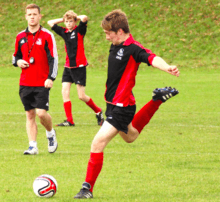
Sports take place at the on-site sports hall, main School hall, swimming pool, Walch Memorial Playing Fields in Cheam Village and Sutton Junior Tennis Centre.
The most widely played sport at the School is currently football, followed by cricket. In Years 7–10, sports team are generally split into 'A' and 'B' teams for each year group. Then, there are four further teams covering Year 11 to Upper Sixth (referred to as the 1st XI, 2nd XI, etc.).
The highlight of the cricket calendar is the 1st XI match against Marylebone Cricket Club.
Houses
Upon entry to the School, pupils are allocated to one of four forms, each form being associated with one of the four houses.[19] In Year 7, pupils are taught within their forms. From Year 8 upwards, pupils are often taught with their peers from other forms.
House Shield
The House Shield is a competition based on house points, awarded for academic and sporting achievement.[19] As part of the House Shield, the following events are held each year:
|
|
|
House Captains
Each year, the House Masters appoint House Captains, who lead pupils in pastoral activities throughout the year. Many address pupils during assemblies, help to organise sports teams, lead the warm-up lap in opening the annual House Athletics Championship and, at the end of their tenure, help to select their successor. They are assisted by a Secretary and occasionally a Vice-Captain.
Combined Cadet Force
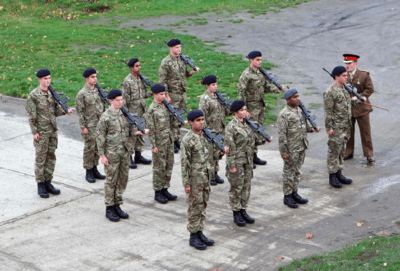
The School has one of the most respected training programmes of all cadet forces in the country.[20] It was raised in early 1915 and officially recognised by the War Office in June 1915.[21] Over the years, boys from the School’s CCF have both served and fought for their country in successive campaigns and wars.[22]
In the late 1990s, sponsored by the Blues and Royals of the Household Cavalry, the Army section of the CCF began to admit girls from Nonsuch High School for Girls and, in 2007, the RAF section followed suit.
The officer team of the CCF is headed by Wing Commander David Hobbes, an ex-Head Cadet and ex-Head Boy. The CCF is under the leadership of this officer team and an annually appointed Cadet Corporal Major (Army section) and Cadet Warrant Officer (RAF section) from the ranks of the Sixth Form cadets. The head of the RAF section has long been Giles Marshall, a current teacher at the School.
In the main building, the World War I memorial lists the names of the 80 boys and one master who died during the War.
More recently, a World War II memorial was built at the Walch Memorial Playing Fields. It was constructed from over 100 stones cemented together in a cairn, each representing a single former pupil who died during the War, and each collected and carried down from over 100 peaks in the United Kingdom. On 15 November 2015, a dedication ceremony was conducted by Old Suttonian Father Jack Noble and attended by staff, former staff, cadets, former cadets, parents and old boys. A guard of honour was held, executed by Year 11 and Upper Sixth cadets under the command of Old Suttonian serving officers, and the names of the dead were read, as well as the Laurence Binyon poem, “For the Fallen".[23]
The Old Suttonians Cadet Association, which is affiliated to the Old Suttonians Association, enables ex-cadets to stay in contact with each other.
-
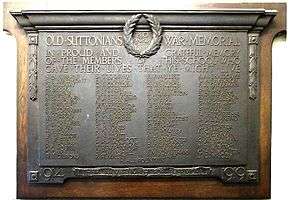
World War I memorial in the main building
-

World War II memorial at the Walch Memorial Playing Fields
-

Old Suttonians, including serving officers and Father Jack Noble, at the World War II memorial dedication
Old Suttonians Association

The Old Suttonians Association is the membership group for old boys of the School.
The Association was originally founded as the Old Suttonians Football Club in 1906, and soon after as the Old Suttonians Association in 1909. Both were formed by a master of the School, Mr S A Birks. 2006, therefore, saw the one-hundredth anniversary of the Old Suttonians Football Club, whilst the Association itself celebrated its centenary in 2009. The Old Suttonians Cadet Association marked its tenth anniversary in the same year.
The Association runs an annual reunion dinner in September of each year and, on a more intermittent basis, reunions for the various year groups, most recently for those at the School under the headmastership of Mr E H Hensley or Mr J A Cockshutt. In 2015, a lunch was held at the Royal Air Force Club to mark Mr G D Ironside's 25th anniversary as Headmaster, at which many Old Suttonians were present.
Subscribing Old Suttonians receive a copy of the School's annual publication, The Suttonian.
There are currently seven clubs affiliated to the Association:
- The Cowdray Club (named after Weetman Pearson, 1st Viscount Cowdray GCVO PC, who gifted the permanent home of the Royal Air Force Club, a London Gentlemen's club)
- The Old Suttonians Basketball Club
- The Old Suttonians Cadet Association
- The Old Suttonians Cricket Club
- The Old Suttonians Football Club
- The Old Suttonians Rugby Football Club
- The Old Suttonians Scuba Club
In its lifetime, the Old Suttonians Association has had a very diverse range of affiliated activities attached to it. A literary and debating society, a cycling and rambling club, chess and bridge clubs, and a very strong swimming club were all in evidence at some point during the period 1909–1970.

Freemasonry
The School has links to Freemasonry, specifically the Athene Lodge, which meets at Sutton Masonic Hall. The Lodge typically publishes a report in the School's annual publication, The Suttonian, with updates on the activities of the Lodge and information for pupils and Old Suttonians considering joining.
The Lodge was established by a group of Old Suttonians who met in 1931 to consider forming a Masonic lodge to meet in Sutton. On 25 January 1932, a petition bearing 23 signatures was forwarded to the Provincial Grand Master of Surrey, requesting approval from the Grand Master to grant a Warrant of Constitution to form a regular lodge to meet under the name “Athena” in reference to the close association to the School. (References are made to Athena, the Greek goddess of wisdom, in The Sutton School Song.) On 10 February 1932, news was received that the Provincial Grand Master, H R H The Prince of Wales, had approved the petition and it had been sent to the Grand Secretary of the United Grand Lodge of England. On 2 March 1932, a new Warrant was issued under the slightly amended name of “Athene” and arrangements were put in place for the Consecration ceremony to take place at Mark Masons' Hall, London, on 10 May 1932. Then-Headmaster of the School, Mr J A Cockshut, was invested as Senior Warden of the Lodge.[24]
In the following years, through loans and donations, Athene Lodge became a Hall Stone Lodge and then a Patron Lodge of the Royal Masonic Hospital in 1939. After World War II, information was received that the contract for the purchase of the Sutton Masonic Hall had been signed and exchanged, and the Lodge contributed 300 guineas to become a shareholder. At a meeting on 17 December 1949, it was reported that a petition had been signed for a Warrant of Constitution for a Royal Arch Chapter to be attached to the Lodge. At the following meeting in February 1950, it was reported that the petition had been approved by the Supreme Grand Chapter and the new Athene Chapter was consecrated on 9 May 1950.[24]
The lodge of instruction, which was sanctioned by the Lodge at the first meeting after Consecration, met at the School for the first 25 years.[24]
Notable staff
- Giles Peter Benedict Marshall – Conservative Party candidate and former chairman of the Tory Reform Group
- Edward Powell – Team GB footballer and coach of England Under-18 and Malawi national football teams
- Chris Robson – actor (films include Tracy Beaker and Dog Soldiers)
Notable former pupils

Politics
- Lord Paddick of Brixton – politician, Liberal Democrat candidate in the London mayoral election, 2008 and former Deputy Assistant Commissioner, Metropolitan Police
- Peter Penfold CMG OBE – former British High Commissioner, Sierra Leone and former Governor of the British Virgin Islands
Science
- Geoffrey Herbert Beale MBE FRS FRSE – leading protozoan geneticist
- David J Farrar OBE – engineer (developed the Bristol Bloodhound surface-to-air missile)
- Douglas Frederick Hooper – psychologist
- Robert Ernest 'Bob' Scott – ornithologist
- Edward Charles Wallace – prominent bryologist
Media
- Richard James Ayre – former Deputy chief executive, BBC News
- Professor David Bellamy OBE – famous botanist, broadcaster, author and environmental campaigner
- James Hartigan – journalist and broadcaster
- Roger Parry CBE – media tycoon
Arts
- Jeff Beck – rock guitarist named fifth in Rolling Stone's list of the "100 Greatest Guitarists of All Time"
- C W E Bigsby FRSA FRSL – novelist and BBC Radio broadcaster
- James Farrar – writer, poet and No. 68 Squadron RAF pilot during WWII
- Adam Riches – comedian
- Jeremy Stangroom – author on philosophy
Sport
- Peter Downes – former Great Britain American football player
- Peter Fear – former Wimbledon FC and England Under-21 footballer
- David Fletcher – former Surrey CCC cricketer
- Matthew Holland – Great Britain Water Polo player
- Mark Morris – former Wimbledon FC footballer
- Alan Derek Piggott MBE – one of Britain's best known glider pilots and instructors
- Tom Williams – Cyprus footballer
Miscellaneous
- Dr Lancelot Lionel Ware OBE – biochemist, barrister and co-founder of Mensa International
Further reading
- Heater, Derek. Keeping Faith: A History of Sutton Grammar School. Ian Allan Printing Ltd.
- Jones, Arthur Edward (1975). A Small School in the Great War: The Story of Sutton County School and Its Old Boys in World War I. ISBN 0-9502933-1-8.
References
- ↑ Heater, D, "Keeping Faith: A History of Sutton Grammar School", p12
- 1 2 Heater, D, "Keeping Faith: A History of Sutton Grammar School", p13
- 1 2 "School History | Sutton Grammar School". www.suttongrammar.sutton.sch.uk. Retrieved 2016-10-07.
- ↑ "Jude Law films his latest Hollywood movie in Sutton". Your Local Guardian. Retrieved 2016-10-07.
- ↑ "Jude Law films his latest Hollywood movie in Sutton". This Is Local London. Retrieved 2016-10-07.
- ↑ "Cheam rapper set to take Fringe by storm". Sutton Guardian. Retrieved 2016-10-10.
- ↑ "Naughty pupils leave a parting gift to school on roof". Sutton Guardian. Retrieved 2016-10-07.
- ↑ TransWorldNews. "Prank on Sutton Grammar School Roof Spotted on Google Earth". www.transworldnews.com. Retrieved 2016-10-07.
- ↑ Telegraph, Top 100 secondary schools by GCSE results 2015, 21 January 2016
- ↑ Independent, 'Elite' state schools contribute to Oxbridge north-south admissions bias, study reveals, 16 August 2016
- ↑ Telegraph, 15-year-old schoolboy develops test for Alzheimer's disease, 13 July 2015
- ↑ Telegraph, 16-year-old devises way to make deadly breast cancer more treatable, 28 August 2016
- ↑ Independent, Breast cancer treatment breakthrough claimed by 16-year-old boy, 29 August 2016
- ↑ Your Local Guardian, Sutton Grammar School pupil Krtin Nithiyanandam from Epsom claims breakthrough in triple negative breast cancer treatment, 6 September 2016
- ↑ Telegraph, Top state schools 'flooded with over 1,000 applications', 6 January 2013
- ↑ Daily Mail, The state school scramble: 13 applicants per place as thousands set to miss out on preferred choice, 1 March 2013
- ↑ "Sutton Grammar School - Sutton - Ball Hall". www.ballhall.co.uk. Retrieved 2016-10-07.
- ↑ Sutton Grammar School for Boys, PE Department website.
- 1 2 Sutton Grammar School for Boys, Official School website
- ↑ Heater, D, "Keeping Faith: A History of Sutton Grammar School", p178
- ↑ Heater, D, "Keeping Faith: A History of Sutton Grammar School", pp30–31
- ↑ Heater, D, "Keeping Faith: A History of Sutton Grammar School", p29 & p70
- ↑ "Sutton Grammar School dedicates its new World War Two Memorial". www.suttongrammar.sutton.sch.uk. Retrieved 2016-10-07.
- 1 2 3 "History of Athene Lodge - www.athenelodge5349.org.uk". www.athenelodge5349.org.uk. Retrieved 2016-10-07.
External links
- Sutton Grammar School website
- Sutton Grammar School Physics Department Website
- Sutton Grammar School PE website
- Ofsted Report 2008
- Ofsted Report 2005
- Athene Lodge website
